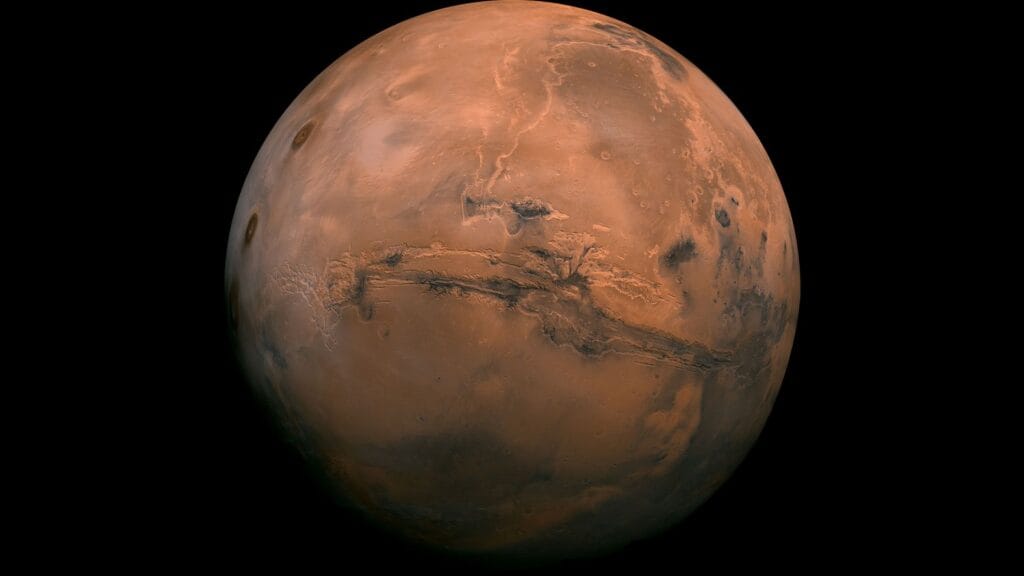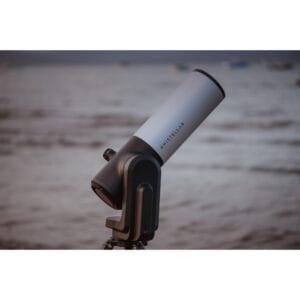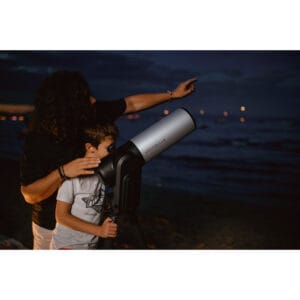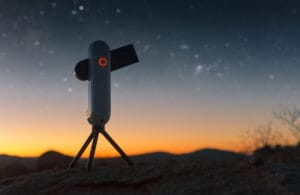Seeing Mars through a telescope is a magical moment for many people. Not only because it’s a nearby neighboring planet, but because with the right timing, proper settings, and a bit of patience (very important!), you can actually observe details on the surface. Think of polar caps, dark regions, and even seasonal changes. But what do you really see, and with which telescope?

(Image: JPL-Caltech/NASA)
Can You See Mars through a Telescope?
Yes, even with a simple 60mm telescope, you can recognize Mars as a small, reddish disk. Under good conditions, you can see the white polar caps and some dark spots on the surface. But to really see structure, you need more.
During opposition, once every 26 months, Mars is closest to Earth. Then it’s not only larger in the sky but also brighter. It’s THE period to observe Mars. Around this time, Mars can appear up to 25 arcseconds large; just enough to make details visible from 100x magnification.
What Exactly Do You See?
At low magnifications, you see Mars as a small orange-red ball. But with 150x to 250x magnification and a telescope of at least 130mm aperture, you can see the following:
✓ Polar caps: bright, white areas of frozen CO₂ and water ice
✓ Dark areas (maria): plains of basalt and sand, like Syrtis Major
✓ Sloping edges: in good seeing conditions you can see Mars’s spherical character
✓ Atmospheric haze: a faint haze around the planet in clear weather
✓ Sometimes: dust storms, these can obscure entire regions
During excellent conditions and with image processing (in astrophotography), you can also recognize Valles Marineris (a 2,000 km long canyon) or Olympus Mons, the largest volcano in the solar system.

Visually, you see Mars as a small, bright orange-red disk. This is due to iron oxide on the surface, the dust that gives the planet its color. At a magnification from 120x, the small ball becomes recognizable as a planet, not a star.

What Do You See with Post-Processing?
Mars is one of the most difficult planets to photograph well… Mars is small, bright, and fast-moving. Yet impressive results can be achieved with stacking and image processing. As shown here:


Mars through a Telescope: Small, Challenging, and Addictive
Those who want to see Mars well through a telescope quickly discover that this red planet is a challenge. It’s not a planet that immediately reveals spectacular images. Yet it’s worth the effort: with proper preparation, you can see polar caps, dark plains (the so-called maria) and sometimes even the terminator line, which is the boundary between day and night on the planet. But how do you achieve that level of detail?
Astrophotographers typically use specific cameras like the ZWO ASI cameras, combined with 8″ Schmidt-Cassegrain telescopes. These are often supported by image processing software like AutoStakkert, Registax, Luminar or Topaz DeNoise AI. But even without all these tools, you can get far as a visual observer.
For most viewers, a 6 or 8 inch Dobsonian telescope, for example from the brand Sky Watcher (available here) (150-200mm aperture) is already an excellent choice. These offer sufficient light gathering to make polar caps visible and show clear contrasts in the dark plains of Mars. You’ll see not just a red ball, but a planet with structure, layers, and character. The image really comes to life, especially when the seeing is good and your telescope is well acclimated.
When is Mars Best Visible?
Mars is best visible during opposition, which is when Earth is exactly between Mars and the Sun. Then Mars is closest to us and appears largest and brightest in the sky. This happens only once every 26 months. The next time this occurs is on February 27, 2027, so it’s smart to plan ahead now and practice with other planets that are easier to see :-).
The best observation moments are when Mars is high in the sky. The higher, the less atmosphere you look through, and the more stable and sharp the image. Use planetarium apps like SkySafari or Stellarium to determine when Mars is at its highest from your location.
Furthermore:
- Avoid moonlight or thin cloud cover
- Let your telescope acclimate to the outdoor temperature first
- Observe from a calm location, out of the wind
- Remember: Mars is bright enough to observe even from the city, despite light pollution
How much Magnification Do You Need?
Mars remains, even during opposition, a relatively small object in the sky. The minimum magnification to recognize it as a planet is around 100x. If you want to see polar caps or distinguish dark spots, you’ll need 150x or more. For serious details:
- 120-150x: polar caps become visible
- 150-200x: dark maria and terminator line are recognizable
- 250x and more: only possible with perfect seeing and a telescope of 150mm or larger
Use a quality eyepiece between 6 and 8mm, or a combination with a good Barlow lens. More magnification doesn’t always yield more detail. Better to have a clear and high-contrast image at 180x than a blurry and unstable image at 350x.
Which Telescope Works Well for Mars?
Mars is demanding. A minimum lens aperture of 100mm is recommended, but for visual observations with real detail display, 130-200mm is ideal. Some strong models:
- Sky-Watcher Heritage 130/650 or 150/750
Light, portable, affordable, and surprisingly powerful for their size. Especially ideal for those observing from balcony or garden. - GSO Deluxe 200/1200 Dobson (8 inch)
An excellent choice for visual planetary observations. Large aperture, lots of detail. - 127mm Maksutov-Cassegrain
Compact with high focal length… more expensive, but perfect for those wanting to combine sharpness and portability.
Want to know exactly what suits you? Our planetary observation guide will help you further.
What Determines the Quality of your Observation?
Seeing Mars well is a combination of technique and circumstances. These factors play a key role:
- Seeing: calm air means sharp image.
- Height above horizon: the higher Mars is, the better.
- Thermal equilibrium: let your telescope cool down outside for at least 30 minutes.
- Optics and adjustment: ensure perfect collimation, especially for reflectors.
- Possible post-processing: in photography, stacking and wavelet processing can reveal much extra detail.
Mars isn’t the easiest planet to observe — especially not for beginners. But the reward is great: a vibrant planet, with visible seasons, polar regions, and dust storms. Even without photography, observing Mars gives a unique sense of contact with another world.
Finally
Mars is fascinating. Not because of its size, but because of its detail. Through proper preparation, you can, even without experience, see how the ice caps shift and how the planet changes as it comes closer to Earth.
The images in this blog show the difference between a simple live view and stacked images with software enhancement. Both are valuable – but it all starts with looking.
Want to observe Mars yourself? Check out our current offers, we have something for everyone.
Mars rarely comes close, so make sure you’re ready!




